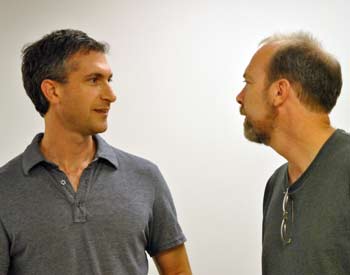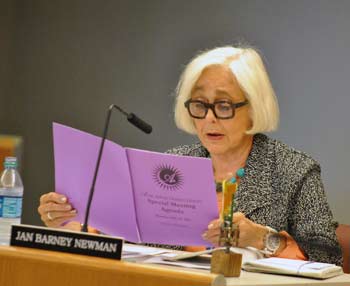Despite Worries, Art Commission Backs Millage
Ann Arbor public art commission special meeting (Aug. 15, 2012): Ann Arbor city councilmember Christopher Taylor stunned many in the arts community by unexpectedly proposing a public arts millage for the Nov. 6 ballot. He took that action at the council’s Aug. 9 meeting – two days after the Aug. 7 primary.

From left: Ann Arbor city councilmember Christopher Taylor (Ward 3) and Mark Tucker, founder of the annual FestiFools and FoolMoon events.
At that meeting, he indicated a desire to start a conversation about public arts funding, and expressed the hope of getting input from the Ann Arbor public art commission and the community in general.
Some of that conversation took place at the public art commission’s Aug. 15 meeting, which ended in a vote of support for the millage proposal.
Much of the reaction so far from the arts community has focused on the short timeframe until the November election, and the lack of clarity that a yes or no vote would indicate, based on the wording of the proposal.
In response to that perceived lack of clarity, on Friday, Aug. 17, councilmember Jane Lumm (Ward 2) added a resolution to the Aug. 20 council agenda that would lead to a choice for voters on Nov. 6 between: (1) a millage to support public spending on art; or (2) no continued accumulation of public funds to be spent on art. Her resolution would direct city attorney staff to prepare ordinance language to repeal the funding mechanism in the Percent for Art ordinance – effective July 1, 2013. The intent is to repeal the ordinance in a way that allows funds already set aside for art to be spent on art, and to provide for maintenance of existing works.
If approved by the council on Aug. 20, Lumm’s resolution would lead in late September to the first of two city council votes necessary to repeal the ordinance section. In part, Lumm’s resolution states that “to truly enfranchise residents, voters should be offered a clear, yes/no choice on public funding for public art rather than an either/or choice of the mechanism used to fund public art; …” [.pdf of Lumm's draft resolution and memo]
Lumm’s resolution hadn’t been proposed when AAPAC held its special meeting on Wednesday to focus on Taylor’s millage proposal. The commission had essentially been forced to call a special session because its next regular meeting, on Aug. 22, falls after an expected vote by the council on Aug. 20.
The special meeting drew more public commentary than at any of AAPAC’s previous meetings. Nine people spoke, including leaders of several local arts institutions: Deb Polich of the Arts Alliance, Russ Collins of the Michigan Theater, Mark Tucker of FestiFools, and former AAPAC chair Margaret Parker, among others. Several more people attended but did not formally address the commission.
It seemed clear that neither commissioners nor members of the arts community who spoke during public commentary had been consulted about the millage proposal, and only a few had been informed that it would be brought forward. While there was broad support for the idea of a public arts millage, many people questioned the timing and felt that 11 weeks until the Nov. 6 election was too short a time to mount a successful millage campaign.
When asked by commissioners who would lead such a campaign, Taylor said he assumed it would be led by the arts community, with money raised from private contributions. He felt the amount of time was sufficient, and that the millage would be approved by voters. He thought the November election would be a good time for the vote, with higher participation by students and renters – that’s a good core, he said.
During AAPAC’s meeting, Taylor told commissioners that if a millage vote is delayed, that puts the current Percent for Art program at risk. He said his sense is that the risk is growing, though he was unclear about why he believes that’s the case. Marsha Chamberlin, AAPAC’s chair, wondered whether the concern stems from a change in composition to the council, following the November election. Taylor did not respond directly to that question.
In the Aug. 7 primary election, Democrat Sally Petersen defeated incumbent Tony Derezinski in Ward 2 – Derezinski also is a member of AAPAC, though he has not attended a regular meeting since May, and did not attend the Aug. 15 special session. No incumbents ran in the Ward 1 and Ward 5 races, where Democrats Sumi Kailasapathy and Chuck Warpehoski prevailed in their respective primaries. No Republican is running against Petersen or Kailasapathy in November. And though Warpehoski faces Republican Stuart Berry in Ward 5, it’s likely that Warpehoski will win that heavily Democratic ward. Taylor is also running for re-election, but was unopposed in the Ward 3 Democratic primary and is unchallenged in November.
In a pre-election survey conducted by the Arts Alliance, Petersen indicated support for the Percent for Art program, though she suggested some changes. Warpehoski supported “looking for ways to establish a more flexible funding stream for the arts.” Kailasapathy did not respond to the survey, according to the alliance, but her campaign website did not list public art among her priorities. [.pdf of Arts Alliance candidate survey]
In general, another complicating factor with the millage proposal is a separate effort to develop a countywide plan and funding mechanism for public art. The Arts Alliance is leading that initiative, and earlier this year applied for a $100,000 grant through the National Endowment for the Arts “Our Town” program to help fund it. At AAPAC’s Aug. 15 meeting, Polich – the alliance’s executive director – advocated for more time so that a fully-developed, comprehensive strategy could be prepared.
Polich questioned how the millage rate was determined in Taylor’s proposal – a 0.1 mill tax for four years. She raised the concern that the city is “leaving money on the table” – that is, it’s possible that voters would be willing to pay more for public art than the amount proposed. Polich also mentioned concerns about the millage’s potential impact on private contributions to arts and cultural organizations, which wouldn’t necessarily get funding from a public arts millage. There might be confusion about that, making fundraising more difficult.
Despite a range of concerns, AAPAC ultimately voted unanimously to recommend that the council place the proposal on the Nov. 6 ballot. Among the commissioners, John Kotarski appeared to be the most enthusiastic supporter of the proposal, praising Taylor for bringing it forward. [Full Story]





